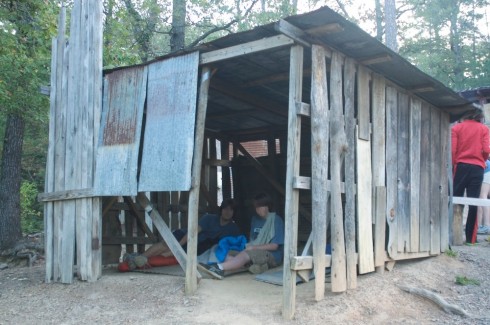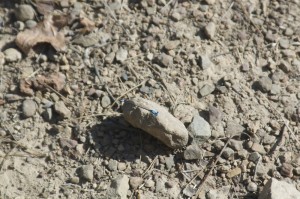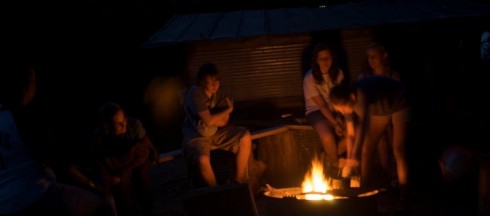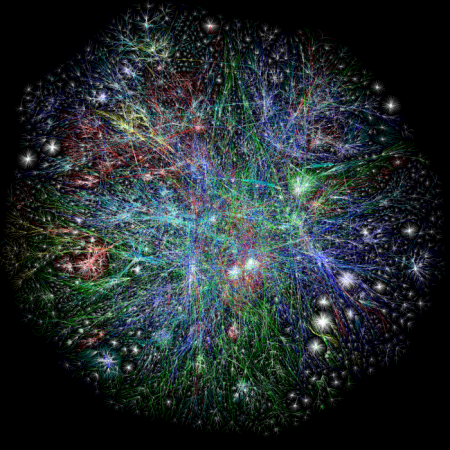We talked about the Voluntary Human Extinction Project (VHMET) in Environmental Science, when we were covering issues related to overpopulation and the need for genetic diversity. While I’ve never been quite sure just how serious VHMET is, I just came across this 2007 article by Robert Krulwich on NPR about a tribe of pygmies in the mountains bordering China and Burma that chose extinction because of all the genetic problems that were being caused by inbreeding.
Tag: poignant
Recycled Instruments: A Cello Made From Some Wood and an Oil Can
“My life would be worthless without music.”
— Young Paraguayan violinist.
The Fulton School has a wonderful music program, so I’m hoping that this video, about how Paraguayan children living in a slum on a landfill have recycled classical instruments out of the trash, resonates with some of my environmental science students.
Landfill Harmonic film teaser from Landfill Harmonic on Vimeo.
Of course, we’ve seen other instruments invented out of discarded trash. The BBC has a brief history of the steel pan, but Trinbagopan.com has an much more detail. On the other hand, I prefer my history in a musical form.
Tweeting as Literature
“Not far from the Surulere workshop where spray-painter Alawiye worked, a policeman fired into the air. Gravity did the rest.”
Teju Cole reinterprets news articles into tweets. The brevity of the tweets intensifies their emotional impact. The story ᔥ NPR.
He’s currently going though the New York newspapers of 100 years ago.
A Night in the Slums (simulated)

One of the highlights of the Heifer Ranch trip was the chance for students to spend a night in their global village. It’s really a set of villages, each simulating a life in an under-developed part of a different developing country.

The Guatemalan house is pretty nice; it keeps you out of the elements, you have actual beds, and running water. The Thai houses are actually pretty awesome. They stand on stilts next to the open fields, giving good air circulation and elegant views. They remind me a lot of some of the older houses from where I grew up. The refugee camp, on the other hand is pretty decrepit. The slums aren’t much better but at least have one house with a wooden floor, though the door was so broken it was pretty useless.
Our students were assigned villages at random, but varying numbers were placed in each village to replicate the population densities more accurately. One adult was assigned to each village. We were supposed to act as if we were incompetent (not hard I know), either as two-year-olds or senile elders.
I ended up in the high population slums.

On the positive side, I was not the only adult there. Mrs H., who had joined our group with her daughter for the week of activities at Heifer, was also assigned to the slums. On the negative side, she and the girls commandeered the one “posh” building that had an actual floor to sleep on. The boys and I had to sleep on the hard, stony ground.
It didn’t help that one of the boys was “pregnant”. One person in each group been given a water balloon in a sling and told to keep it with them, safe, until dinner, when they would “give birth”, at which point the others in the “family” could help take care of the “child”. A key objective was for the child to survive until morning.
The boys scouted all the houses in the village and scavenged a large piece of metal grating to sleep on. It was not great, but it was doable. Better, at least, than the concrete-hard, uneven ground.

There was a lot more that happened on that night. None of the groups was given enough to be comfortable on their own. There was a lot of haggling, trading and even commando raids, but, in the end, they pulled together and made something of it.
The experience was quite useful, I think. Conditions were uncomfortable enough to register with the students, though a single night is not enough to really internalize all the challenges of urban slums where over one billion people spend their lives. But it does provide some very useful context for the poignant images of Jonas Bendiksen (Living in the Slums) and James Mollison (Where Children Sleep).

Loom: Spider Catches the Moth
Mapping Internet Space

The Opte Project has produced a number of excellent maps of the internet. There is a profound beauty in the immensity of the interconnections that’s reminiscent of the suffusion of stars that can be seen in Milky Way on a dark night on an isolated beach. Unfortunately, their website seems to have not been updated since 2005.
Storm: Life is Precious
I try not to post things with anything approaching obscene language, but sometimes, as in this piece, called “Storm” by Tim Minchin, it’s a small part in the service of a much bigger, more significant idea. Anyway, this one might not be for the kids.
Osama bin Laden: A Montessori Discussion
[…] the whole idea of revenge and punishment is a childish daydream. Properly speaking, there is no such thing as revenge. Revenge is an act which you want to commit when you are powerless and because you are powerless: as soon as the sense of impotence is removed, the desire evaporates also.
Who would not have jumped for joy, in 1940, at the thought of seeing S.S. officers kicked and humiliated? But when the thing becomes possible, it is merely pathetic and disgusting.
–Orwell (1945): Sour Revenge in the Tribune. (Found via Megan McArdle).
Over the last couple of weeks, students have been reading and presenting newspaper articles every morning, so, inevitability, we had a few good opportunities to discuss the death of Osama bin Laden.
The discussions were remarkably mature, and quite edifying to hear, because it was pretty much what one would hope to occur among Montessori kids who’ve been dealing with the peace curriculum since pre-school.
There was remarkably little jubilation. So much so, that one student asked, “Are we not supposed to feel happy?”
The answer was that yes we can feel happy and relieved but we shouldn’t “spike the ball”, letting the celebration get so out of hand that it antagonizes bin Laden’s supporters even more, and makes us seem as arrogant as they caricature us to be. If we want to achieve peace we need to be better than that.
Their broader perspective is somewhat akin to what Thich Nhat Hanh, a Zen monk, expressed a couple weeks after the September 11th attack (thanks to Julie H. for the link to the interview by Anne A. Simkinson).
All violence is injustice. The fire of hatred and violence cannot be extinguished by adding more hatred and violence to the fire. The only antidote to violence is compassion. And what is compassion made of? It is made of understanding. When there is no understanding, how can we feel compassion, how can we begin to relieve the great suffering that is there? So understanding is the very real foundation upon which we build our compassion.
[…]
There are people who want one thing only: revenge. In the Buddhist scriptures, the Buddha said that by using hatred to answer hatred, there will only be an escalation of hatred. But if we use compassion to embrace those who have harmed us, it will greatly diffuse the bomb in our hearts and in theirs.
–Thich Nhat Hanh (2001): What I Would Say to Osama bin Laden (Interview by Anne A. Simpkinson on BeliefNet.com)
There’s also a poignant reflection by Megan McArdle, a New Yorker, who was, at first, extremely angry and eager for revenge, but has become much more reflective, and cognizant that we share both humanity and mortality with even Osama bin Laden.
McArdle elaborates more here.